Guest Post by Daniel Sokol
I started my container business because I wanted one for myself. My goal was a practical, well designed, cost-effective living space. Being an interior contractor, I had the skills for the finish work but never worked with a shipping container.
Everything I saw online was either an extremely expensive “one off unit” or renderings of proposed containers. My research didn’t yield enough useful construction information so I learned as I went along and made a lot of mistakes. The learning curve was a wonderful experience and, after building several containers, am still learning and experimenting with different components and designs.
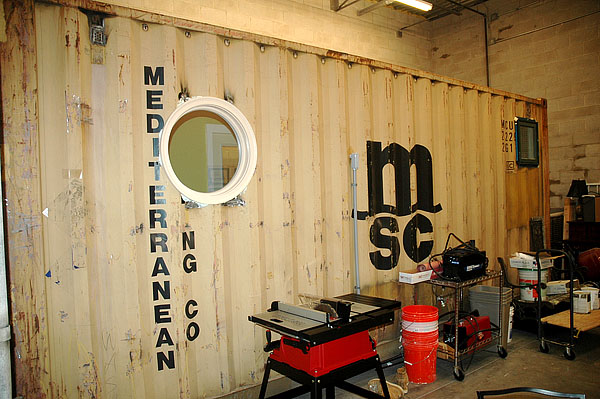
A shipping container, used as the primary construction unit, has almost unlimited possibilities for any living environment (desert, mountains, forests, etc.) Although the
housing industry is in a major transition – along with our country – I believe there is a future for small, energy efficient, well designed living.
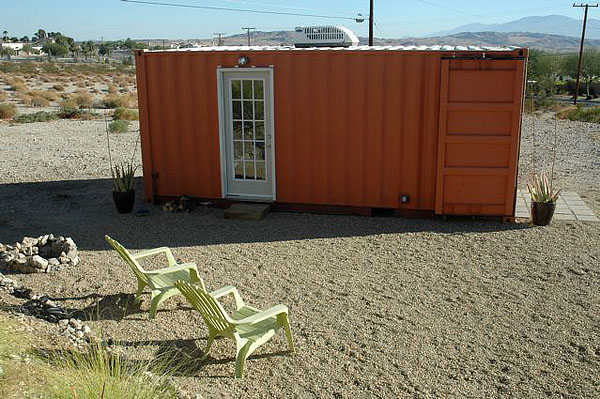
After building a container cabin for myself, I now build for others. My site is www.leedcabins.com (it appears they are no longer in business) and I am located in New Hampshire. I have customers in Oregon, California, Mississippi and New Hampshire.
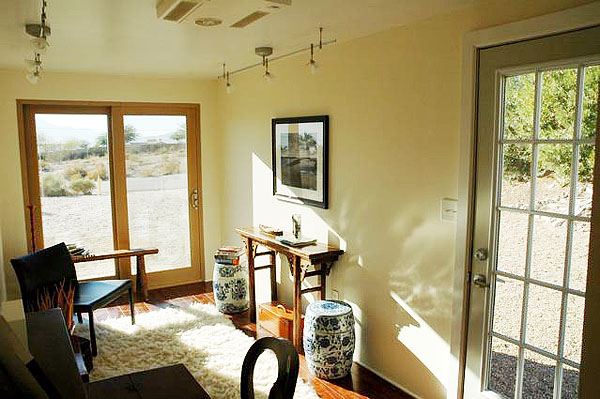
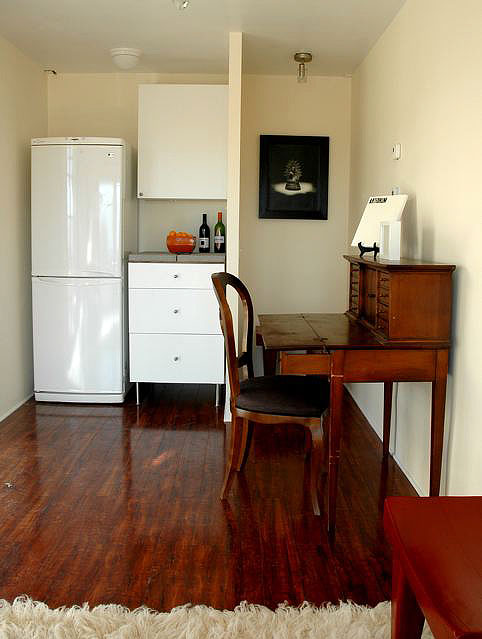

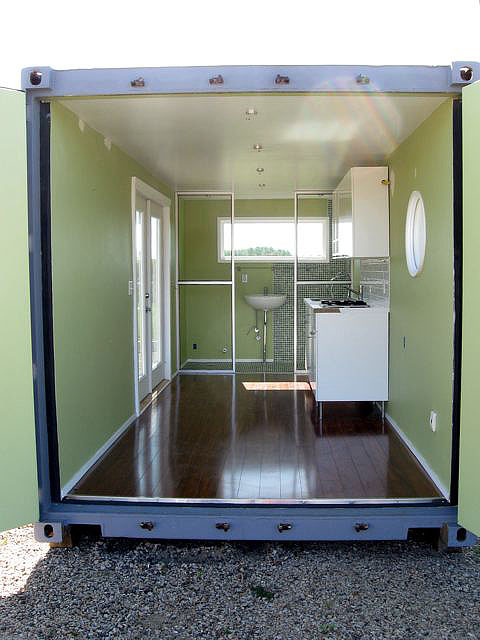

the interiors look good but the exterior is still a container. There is no attempt to add guttering or extra shade.In a hot climate you would cook in these containers so for this reason I say “back to the drawing board “
This has a charming, simple design. I like the large, enclosed shower room, which I can envision installing an ofuro bath in.
Robin, Using closed cell foam insulation negates the need for extra shade. The interior roof cavity was more than sufficient to stop heat transference. Yes, in a damp climate using a gutter would be helpful (and to collect water). This desert container was very comfortable and A/C was installed as well for really hot days although it wasn’t used too often. Dan Sokol
I’m looking to purchase a 20’high top container home for myself. How do I contact you?
an awning would do it.. as an accessory… not unlike a CHAIR or a patio.
I could see a all encompasing “fly leaf” over the unit and ‘patio’ which might help with rain on a metal roof…
an awning would do it.. as an accessory… not unlike a CHAIR or a patio.
I could see a all encompasing “fly leaf” over the unit and ‘patio’ which might help with rain on a metal roof…
Personally speaking, I like the industrial look of a container. It requires virtually no maintenance and is mold free and doesn’t rot. It’s also bullet proof – nice to have during hunting season!
So Neat!!
I have lived in containers aboard ship and in multiple foreign destinations for months at a time. With appropriate insulation and airflow, they can be comfortable and secure residences. There are multiple projects around the world in Denmark and other locations as well as the Battle Box concept that are proven designs. Good luck and nice job!
David, Many thanks for your kind thoughts. Feedback, comments and criticism are most welcome! Dan Sokol
@ Robin Yates
The first finished one, painted orange, looks to have an AC unit and a white painted roof and looks situated in the desert. I think a second roof, much like old desert landrovers would be useful 🙂
Is it less expensive to purchase, transport and modify a shipping container than to purchase, transport and build out of wood, straw bale or some other medium? I realize the benefit of re-using the shipping containers as they are often not used on the return from their destination. However, from a strict cost basis, does it pencil out as less expensive?
Carey, I have never built a home using the materials you described so I cannot answer you with accuracy. The he price of used 20′ containers has gone up considerably – from $750 in 2008 to over $2,900 currently. It definitely affects the cost of a $20,000 container unit – especially when traditional stick homes can be bought for as little as $80,000 in some markets. Dan Sokol
Not quite the same, but I have a 48′ former postal trailer I bought at auction for $700 almost 20 years ago. It has oak floors over an inch thick and steel reinforcements all the way around. It is STILL in excellent condition and has never leaked! I used it for storage but am turning it into an art studio. There are tons of these trailers very cheap, and like mine, they are easily moved because they still have the tires. Look for one at a business auction in good shape, not one that’s been sitting in a field. Thanks, Dan, this IS a great alternative!
Can these be shipped for use in Canada?????
Check with any major East or West Coast port. I’m certain Canada is gaining in shipping containers just like your Southern Provinces ;-).
Sandi, Yes! Absolutely anywhere a truck can go containers can be delivered. I call independent shipping brokers for pricing – you’re more than welcome to provide your own as well. Dan Sokol
VERY cool bathroom!!!
I renovated and tiled many bathrooms in NYC and learned my skill from an old Italian master. Preparation and square corners are key to a successful project. Dan Sokol
PS – The green tile was made from recycled glass and cost $9.00 per sq/ft.
negatory big bird
I wonder if you could put a solar roof on the thing – I really like the inside, seems nice and light!
Robbie, If you’re thinking of solar panels, the answer is yes. Do you mean skylights? I wouldn’t do it unless you want to do a significant amount of reinforcing and welding. The structural integrity is compromised. Dan Sokol
I keep thinking there has to be a way to utilize container housing in the Arctic. There is a shortage of any housing, let alone decent housing, and a lot of containers from the summer sealift freight. You’d think the two would mesh up somehow.
I was contacted from someone in Alaska and, yes, the two would mesh up very well. My shop is in NH and shipping across the country runs about $3,000. If you then add the freight and unloading and delivery costs from the west coast to Alaska, it gets expensive. Maybe someone can build them in Alaska.
It looks like you have used drywall for the interior finish in a lot of these units. Do you encounter cracking or damage to the interior finish due to travel of the containers upon completion?
I have shipped across the country, had one dropped a couple of feet while loading onto a truck, banged into a building while unloading, dragged one across a bumpy gravel road and didn’t experience cracking.
I worked for several years in North Africa’s Sahara Desert. Many shipping containers were easily and quickly converted to a variety of human-occupied purposes; offices and sleeping accommodations, primarily. None of the occupied containers were left without a shade cover, some 1 and a half to 2 feet above the top of the container. You’d cook, even with the A/C going full blast otherwise. Make sure you offer a shade cover, at least, as an option to customers aiming to live in a desert or excessively hot area. They’ll certainly be happy they did.
I will. A minimal amount of shading significantly reduces heat transfer. The desert container was surprisingly cool although hot to the touch. Closed cell foam is a very effective insulation. I am waiting to hear from the owner about the effects of July and August and will probably be designing a shade roof and awning for them soon. Dan Sokol
It might look good with a series of curved pipes supporting a canvas shade roof a few inches over the top. The curve would provide drainage too.
Which reminds me… How does a flat level roof of a container drain? You’d think it would need some slope to avoid puddles and possible resulting rust damage from sitting water.
I have followed the Shipping Container as buildings for many years now and someday hope to use one(several) in a project. Great Job on your work.
I live in the Interior of Alaska and builder friends talk about the transfer of cold through the metal as an issue. We have a great organization here in Fairbanks, a Residential cold climate research center run by Jack Herbert’. Look it up.
(I still think we can make it work here-who knows?)
Jim, I will look at your site. Shipping containers are extremely airtight and have no heat loss through drafts (except venting and A/C units). Conductive loss, occurs with metal window and door frames. You can’t change physics! Thank you for the web site suggestion. Dan Sokol
I always liked the idea of container homes and as far as the exterior goes you can finish it off yourself and save the cost, or you can bury it in the side of a hill with a glass wall facing south and add awnings etc. A sod roof can also be added. People in hot climates also build light weight canopies over the entire container to shade it. There is no end to what can be done with these containers. They are probably more suited for wooded rural areas which is just fine with me. It just too bad that the greedy tax collecting politicians are already ruining the business with their “fees and Permits etc.” Then they spend our money like a bunch of drunken sailors. I always say that if you fail at everything elese in life and if you can’t even run a lemonade stand without losing money, then go into politics.
Nice job!
Walt Barrett
Best ideas yet for placement and rooftop!
Walt, Many thanks for your kind thoughts! Take a look at the contact page of my web site regarding the politics of container homes. Drop me a note, I can tell you of more incredible experiences! Dan Sokol
I like your idea, Mr. Barrett. If I owned land and had enough money, I might be tempted to make my own personal “Bag End”.
I like the narrow refrigerator in the kitchen. What kind is it and is it shown on a website somewhere?
The fridge is an LG and measures 24x24x74 w/ freezer on the bottom. Extremely efficient unit and the cost was about $750. An EXCELLENT product.
I don’t see a sink in the little kitchen. Is it hiding somewhere?
Ben, the sink is in the counter – stainless dual sink w/ single lever faucet.
Behind or under the bowl of oranges?
My apologies, that container is used for displaying art and reading and doesn’t include a sink.
Any ideas for one with 2 bedrooms?
Joining 2 containers – maybe add an atrium? I don’t believe in stacking (unless in a city) because of the loss of floor space to accommodate the stairway.
Would a spiral staircase work as far as stacking them goes? Sounds like it could be a pretty cute idea
Spirals would work but personally I do not like them (especially if you have dogs). The loss of floor space would approximate 12 sq/ft per floor. They do provide an interesting design accent.
Has anyone looked at “Air Krete” cement foam insulation. I was leaning toward the close cell stuff but it burns, Air Krete doesn’t.(just look up Air Krete on You tube.)
I’ve been turning over putting a few of the 40’HC’s together in S.W. Alaska but outfitting(framing/electrical/water/bathrooms)here in Oregon and then putting them together in Alaska. That’s the main reason the Air Krete Insulation got my attention.(a plasma cutter/cutting torch/grinder won’t set that type of insulation on fire.)
Nice job on your containers, Dan.
I will definitely take a look. That you for the recommendation.
I’d love to see four – or even six – put together with a central courtyard.
I just gotta overdo it. 🙂
I’ve also looked into shipping containers, as a residence and a garage. In this city, they allowed one to be built last year, or maybe the year before, it looks wonderful, you’d never know it started out as containers. How much insulation did you put into the walls and ceilings? And the brand? Thanks for the refrigerator info, looks like a perfect size for my needs.
And I love the bathroom….WOW, wonderful job !!
I filled the cavities to the edge of the stud with un-branded, CFC free closed cell. The ceiling cavity was over 5″ in most areas. It’s the most expensive part of the conversion ($$$) but necessary. A sub was used for spraying and clean up – it’s a messy job. However, I purchased from a local supplier for containers when I was ready to seal the undercarriage. Still looking for the ideal supplier – when I find him I’ll pass it on.
Do you have floor plans?
My web site has a few available for 20″ and 40′ units. I am happy to customize to fit your needs.
Hi Dan!
Love what you are doing and have been enamored of containers as residences for several years now. I do like the look of the IQ Haus Star-t model(http://iqhausa.com/iqstar-t.html)–I saw it at the Dwell show and it was nicely finished. My biggest concerns are the San Diego building codes and finding a piece of property to put it on (urban in-fill would be ideal). Thoughts?
That’s a tough one. I actually close my west coast operations due to objections of the local planning/zoning officials. They appeared to be more interested in protecting their job than accepting the realities of the housing market.
That’s a tough one. I actually closed my west coast operations due to objections of the local planning/zoning officials. They appeared to be more interested in protecting their job than accepting the realities of the housing market.
hello, need help pls looking into getting a container in the arizona desert but concerned about the heat what matrial do we need to buy to protect us from the heat living in a shipping container, thank you
Using closed cell foam insulation will negate most of the heat problems, however, I would recommend using a shade or sun deflector to cure the problem of heat conductivity.
I once had the letters you could send for…way back when you had to mail things…for a boxcar house. It was made in Canada, and inside it had everything from paint, windows, aprons, nails and hammers and tools, oh my!!
It was amazing and I wanted it soooo bad but didn’t have 25k. Can you imagine what that kit would cost today?
I love these, think they are functional and effecient. Keep up the great work!!
Sandra, I had the same dream and think it would be great to have a railroad car for a living or studio structure. There are abandoned cars out there, but the moving costs would be substantial – not to mention setting up the rails and ties to park it on for the full effect. I remember reading and watching Bradbury’s Fahrenheit 451 and the community of book people living in the woods.
The Waldorf School of Orange County in Costa Mesa has recently built their high school utilizing shipping containers. It’s quite something. I wonder if that will open the door for container residences in the county?
I hope so! If you read comments on my “Contact” page you will learn why I closed shop in CA. I was surprised even in places like Desert Hot Springs there was a huge resistance to container homes.
These are great – I really like your 40′ designs! What kind of foundation do they require?
The type of foundation is dependent upon utility hookup and frost zone. A minimum of eight cement columns works well – you need to provide evenly spaced support along the main beam and weld the container to steel plates on top of the columns.
Simply fantastic. Mr.Sokol, are containers only viable in certain areas of the country- would they not be optimal in the northeast?
I’m chemically sensitive so having house built entirely out of metal would be a Godsend! What’s the biggest square footage? Could I have a real bathtub put in if I don’t want a shower?
The thing is….where to put it…..
Irene, A 20′ unit is 160 sq/ft while the 40′ is 320 sq/ft. How big of a home do you need? Keep adding containers until you reach the desired size. Three 40′ containers is spacious inside!
Gregory, Yes, they are viable. They don’t rot and get moldy like wood and are also bullet proof (handy during hunting season up north).
I’m thinking about renting a container home while I am working in the Northeast US. I found a Kalkin home, the “old lady”, http://www.trendhunter.com/trends/old-lady-house . I’ve been trying to find out experiences of people living in the container home, not so much the design and construction. If we like living there, we may pursue our own container home. Anyway, thanks for the site and info
sorry, wrong link
http://inhabitat.com/adam-kalkins-old-lady-house-is-a-modern-shipping-container-masterpiece/adam-kalkin-old-lady-house-9/
I am just wondering what was the residence to the great idea in Desert Hot Springs, California???
Have rural land and was thinking about containers
Thank You
R Frank
Resistance……………….
Hi! I just wanted to ask if you ever have any problems with hackers?
My last blog (wordpress) was hacked and I ended up losing months of hard work due to no
backup. Do you have any methods to prevent hackers?
Very good post. I will be going through a
few of these issues as well..
I’m very interested in container homes. Are there restrictions in some cities or towns to own one.?..do you have a brochure of samples you could mail me?
Have you put 3 or more containers together to make more square footage?
are you still available for builds? i checked out the site but it goes to a site of other links.please email me if your available for NH build
Hi Shawn, I’m assuming they are out of business if the website is no longer there. I will check and see if I can learn more.